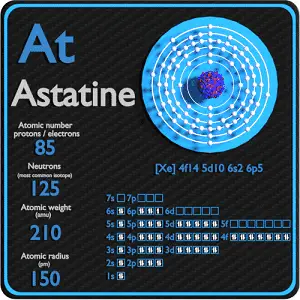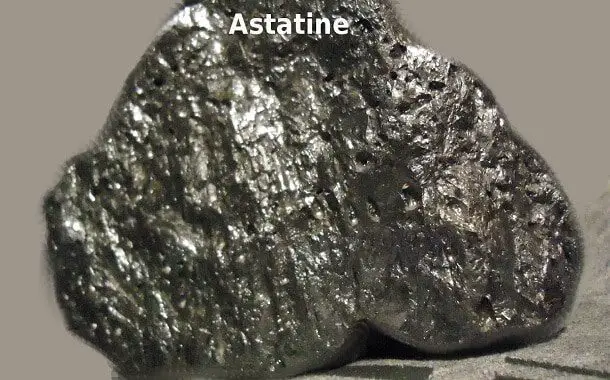Astatine Prices – What Should You Expect?
Last Updated on April 30, 2024
Written by CPA Alec Pow | Content Reviewed by ![]() CFA Alexander Popinker
CFA Alexander Popinker
Astatine is one of the rarest naturally occurring elements on Earth. With less than one gram produced annually worldwide, this unstable halogen’s tiny supply and difficult synthesis leads to an extraordinarily high cost.
What exactly determines the price tag for astatine? This article analyzes the complex interplay of factors like production challenges, specialized applications, regulations, and handling precautions that underpin this element’s valuation.
How Much Does Astatine Cost?
Astatine cost is directly influenced by its rarity and radioactivity exceeding $5,000 per milligram, making each gram worth over $5 million!
Over the decades, the reported market price for astatine has swung dramatically – from $6,000 per milligram in the 1980s, down to $3,000 by the 2000s, and back up to around $5,000 today. What drives such volatility?
Supply and Production Bottlenecks
- Global production totals less than 1 gram annually due to miniscule natural availability and technical barriers to artificial production. This scarcity enables sellers to command exorbitant pricing.
- Methods like bombarding bismuth-209 with alpha particles require nuclear reactors or particle accelerators, limiting viable producers.
- The most stable isotopes have half-lives of just hours or days, necessitating constant production.
Niche Sector Demand
- Primarily purchased by research institutions and some specialized pharmaceutical companies.
- Critical for physics and chemistry experiments probing theoretical properties.
- Emerging niche uses in experimental cancer treatments provide high value.
With consumption rising among some buyers but supply heavily constrained, we can expect astatine prices to remain very high for the foreseeable future.
Luciteria offers an Astatine Lucite Cube for $2,400.00, making it one of the most expensive elements available for purchase.
NCBI discusses the production and availability of Astatine-211, highlighting the low intrinsic cost of producing this radioisotope for cancer therapy, estimated at around $30 per millicurie (mCi).
Introduction to Astatine
With the chemical symbol At and atomic number 85, astatine occupies a curious position in the periodic table. As the heaviest member of the halogen group, it sits beneath its lighter cousin iodine. But unlike other halogens which are relatively abundant, astatine’s fleeting existence makes it a scientific enigma.
Naturally occurring astatine exists only in infinitesimal amounts due to its radioactivity. Nearly all supply comes from specialized production in nuclear reactors and particle accelerators.
For science enthusiasts, astatine’s mystique provides strong appeal. But its high reactivity and short-lived isotopes also confer unique properties that researchers believe may prove useful for specialized medical treatments down the road. In this article, we’ll unravel the many interlocking factors that determine this scarce element’s sky-high valuation.
Return on Investment in Astatine Production
Does astatine production justify the substantial effort and infrastructure required? For the few organizations equipped to handle the challenges, the incentives line up:
Lucrative Revenue Stream
- Each gram sells for ~$5 million, providing millions in sales revenue.
- Production costs, while high, remain below market values.
- Niche demand is inelastic – buyers will pay premium prices for even tiny quantities.
Competitive Edge
- Astatine suppliers gain prestige and recognition in the scientific community.
- This can help attract funding, collaborations, and talented researchers.
- There are strategic advantages to having unique access to an extremely scarce material.
However, the field is limited to institutions with nuclear capabilities like national laboratories and elite universities. The risks and costs shut out most commercial producers.
Scientific Properties
Several characteristics inherent to astatine underpin its economic potential:
Negligible Natural Abundance
- Occurs only in trace amounts naturally due to radio decay.
- Synthesis via particle accelerators or nuclear reactions is the only viable production method.
Radioactive Decay
- All isotopes are radioactive and decay rapidly.
- Most stable isotopes have half-lives of just hours or days.
- Constant production is needed to replenish scarce supplies.
Chemical Reactivity
- As the heaviest halogen, it has unique chemical properties.
- Research suggests it behaves more like iodine than other halogens.
- Ability to bind with proteins gives medical utility.
These fundamentals make astatine invaluable for physics research and medical advances, justifying ongoing production.
Uses in Medicine
 While still experimental, astatine shows intriguing potential for use in niche cancer treatments:
While still experimental, astatine shows intriguing potential for use in niche cancer treatments:
Targeted Alpha Emission
- Being an alpha emitter, astatine offers more localized effects on tissues.
- This makes it useful for eradicating small tumors while minimizing collateral damage.
Concentration in the Thyroid
- Like iodine, astatine tends to concentrate in the thyroid gland when introduced to the body.
- This makes it uniquely suitable for treating thyroid cancers via internal radiation therapy.
Development of Targeted Therapies
- Astatine-211 is the most promising isotope for radiotherapy applications.
- Active research surrounds bonding astatine to carrier molecules for delivering radiation directly to cancer cells.
While still speculative, this promise justifies the immense time and resources devoted to handling this temperamental element.
Precautions due to Astatine’s Radioactivity
Safe handling of astatine requires extensive precautions:
- Decay product radon-219 necessitates performing all work in sealed environments.
- Structural materials that limit radiation exposure are vital, including lead, glass, and plastics.
- Automated systems and specialized tools reduce human exposure.
- Waste must be stored long-term before safe disposal due to continued decay radiation.
These essential measures add substantial infrastructure costs to working with astatine. However, the safety of personnel and caution against environmental contamination come first when harnessing the power of radioelements.
Impact of Emerging Technologies
Advances that increase the efficiency and scale of astatine production could disrupt the market:
- More compact, lower-cost particle accelerators could enable new suppliers.
- Improved isolation and storage methods would extend the viable working life of batches.
- Novel target materials or particle capture systems may boost yields.
- Computer modeling of chemical reactions and decay kinetics could inform synthesis optimization.
If these emerging technologies significantly expand supply, prices could face downward pressure. However, consumption may also increase in tandem if medical applications grow.
Final Words
For most applications, the incredible scarcity, radioactivity risks, and prohibitive $5,000 per milligram cost of astatine places it firmly out of reach. But its radiotherapeutic potential and scientific novelty make it a worthwhile investment for leading physics laboratories, radiochemists, and some cancer researchers in the short-term.
Until fundamental production economics shift, astatine will remain a coveted darling in the scientific community. And its exotic mystique will continue capturing our imagination. While astatine itself disappears in the blink of an eye, the memory of holding one of nature’s rarest creations could leave an indelible imprint on researchers fortunate enough to work with this ephemeral element.
Frequently Asked Questions
What makes astatine special?
Astatine’s fleeting existence as the rarest naturally occurring element, its radioactivity, applications in cancer treatment, and position as the heaviest halogen give it great scientific appeal. It provides a window into the frontier of the periodic table.
What is the most expensive useful element?
Francium is considered the most expensive practical element, with price estimates as high as $1 billion per gram. Like astatine, its combination of radioactivity and incredibly tiny natural occurrence make it enormously challenging to produce in usable quantities.
Can astatine soluble in water?
Yes, astatine can dissolve in water. However, it rapidly tends to undergo hydrolysis when in aqueous solution due to its high reactivity, making it difficult to work with in water over extended periods.
What can astatine bond with?
Paralleling iodine, astatine can easily form astatides with metals like sodium, potassium, and lead. It also combines readily with hydrogen and carbon. And emerging research surrounds bonding astatine with larger carrier molecules to enable targeted cancer treatments.



Leave a Reply
Want to join the discussion?Feel free to contribute!